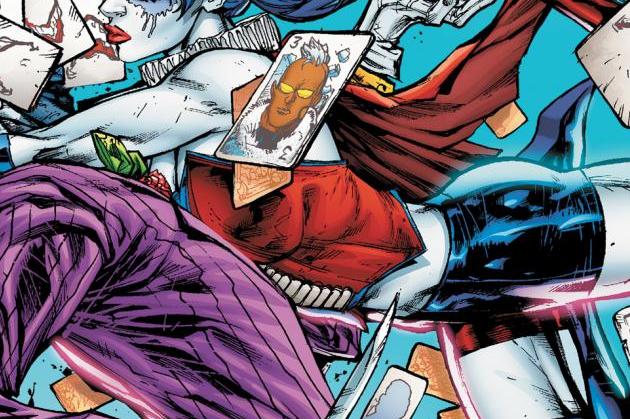Suicide Squad #15
SPOILERS... IN DISGUISE!
(Sincere apologies in advance to my ladyfriend, Lex, who is a Harley Quinn fan and faithful monthly Suicide Squad reader since the title premiered. Never stop reading what you love. Especially not because of me.)
Occasionally I'm presented with a character whose repugnance I have to ignore in order to delve into the nuances and complexities thereof. The Joker is one of them. I'm tired of the Joker. The year he was gone from DC was one of my best years in comics. But now he's returned with a suffocating ubiquity that has me squirming with discomfort through almost every Bat-title being published right now.
I picked up Suicide Squad #15 as part of the Death of the Family crossover, hoping to see resolution to the Harley Quinn/Joker dynamic, and perhaps even a streak of the whimsical Harley Quinn we used to know. Instead I saw a forced, generic and ham-fistedly over-sexualized Harley with little resemblance to the character I formerly loved. I watched as the Joker, a character growing ever darker and more evil with each decade, killed off much of the nostalgic playfulness I adored in Quinn's character. I was disappointed at the end, feeling lonely and unsatisfied. Although it features Quinn and Joker from cover to cover, this is not a book I recommend if you love either character.
The book also features some dry, arbitrary and useless exposition from the random insertion of Amanda Waller for no more than two pages, talking about the events of the book with a character named “Yo-Yo,” about whom I've never heard and can guarantee nobody cares. On an unrelated note, I still find it unsettling that Waller is now 20 years younger and 150 pounds lighter after the New 52 reboot. Hilariously, comics just keep getting more sexist as time goes on.
Apologies. Back on topic.
The art, presented by Fernando Dagnino and colorist Matt Yackey, was all flash and no bang. Forgoing any sense of scenery or atmosphere, there are instead only colored panels with Joker and Harley fighting and yelling. I was unimpressed and had a vague disappointment throughout that the inside art didn't look more like the Ken Lashley cover. Yackey's coloring is dissonant and nervous, and I don't mean that in a good way. His palette is as incoherent as the wooden, by-the-book dialogue between the two former lovers.
I picked up the book expecting better—something perhaps more rich and bittersweet than the stiff story and sour coloring I got. But my biggest disappointment is the direction of these two characters. Both are characters I once came to love as Harley once loved Joker: with a sense of light-hearted mischief. Knowing it's wrong to sympathize with the villain, but not caring about the consequences... seduced into a playful sort of evil by the colors and music of a circus. Now, by gradual decline, they have devolved into characters I loathe as much as they now loathe each other—both vile in their own right, both frustrated in their utterly misplaced affections, and both empty of the magic they once held.
The Joker, ultra-insane, inhumanity incarnate, is always evolving. Snyder's writing in the primary Batman title is helping me accept this, as did Morrison's work during his run on the same. However, the changes to Harley Quinn in this book are too random and too difficult for me to endure. Between the unpleasant art, brittle writing and cruel mishandling of a beloved character, this issue falls short on all counts.





